Google Nexus 5 Review
by Brian Klug on December 5, 2013 8:00 AM EST- Posted in
- Smartphones
- LG
- Android
- Mobile
- Snapdragon 800
- Android 4.4
- Nexus 5
It goes without saying that battery life is one of the huge cornerstones of smartphone evaluation and critique. In the case of Nexus 5, the battery is a 3.8 V, 2300 mAh 2D battery giving 8.74 watt hours total. Looking only at battery capacity doesn’t always tell the whole story, since obviously it’s just a tank to draw from – the overall efficiency of the entire system and the sum of the energy drain of its parts determines how long the platform will last. The comparison point of course for the Nexus 5 is its close cousin, the LG G2, which has a 3000 mAh (11.4 Whr) stacked (3D) battery by LG Chem. Smartphone battery sizes have been increasing for a while now, and the reality is that Nexus 5’s is indeed on the smaller side given its display.
As I’ll talk about later, one thing the Nexus 5 has over the LG G2 is a QFE1100 envelope tracker for its cellular power amplifiers, which lowers power consumption by up to 20 percent, the same RF360 part we saw in the Galaxy Note 3. Interestingly enough the LG G2 shipped with a variant of this same family, QFE1101, which works in an APT (Average Power Tracker) mode instead, whereas QFE1100 works in both APT and ET modes. I’ll touch on these in the relevant section, but it’s important to note that in the cellular tests one of the big consumers of power (power amplifiers are easily the number two after display) has the bleeding edge component available to curb consumption and is literally the second handset on the market to include it.
To evaluate battery life we turn to our battery life testing suite, which we run over WiFi and all the cellular interfaces appropriate for the device. Here we see a good combination of regular spikes in CPU usage with idle time, hopefully simulating constant, reasonably paced usage. As always the display is set to exactly 200 nits and configured the same way we always configure devices for maximum consistency.

On WiFi, we see the Nexus 5 start off pretty well, behind the G2 and the newest 8974 phones, but no slouch at all, and considerably better than the Nexus 4. Of interest is how the Nexus 5 slips 16 percent versus the G2 despite having a 23 percent smaller battery.
For cellular, it’s the same workload as always. Since the Nexus 5 now has LTE, I went back and re-tested the Nexus 4 with LTE enabled for a closer comparison. Although the Nexus 4 never shipped with LTE officially enabled, the device included it on Band 4 for some time until a baseband update finally locked it out for good. I flashed back down and ran the test just for the sake of completeness, and since I Know there are a fair amount of people out there using the Nexus 4 on LTE still. Of course I also tested on 3G WCDMA.
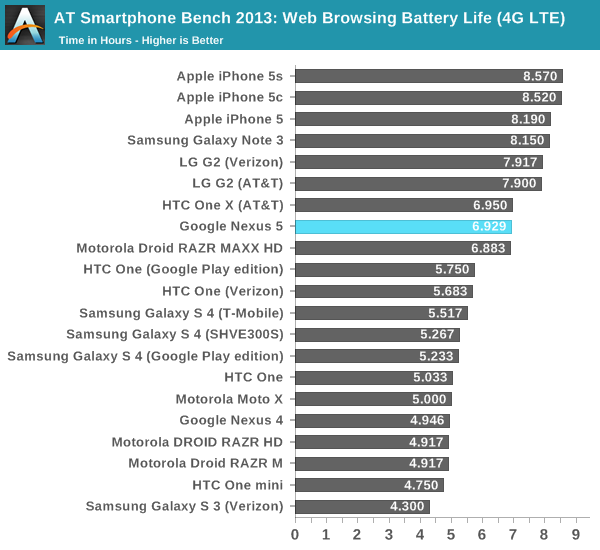

The Nexus 5 comes out far ahead of its predecessor on both 3G WCDMA and 4G LTE, although that’s fairly unsurprising given the year of improvement, different process (28nm HPM), envelope tracking, and battery size differences. The more interesting comparison point is the LG G2, which Nexus 5 can’t quite catch. Clearly the RF front end differences make a difference, otherwise the scaling would be 23 percent less battery on cellular, instead it is 12 percent on LTE. On 3G there’s a bigger delta however, almost 33 percent worse than the G2’s impressive result. Still, the Nexus 5 on LTE is no slouch.
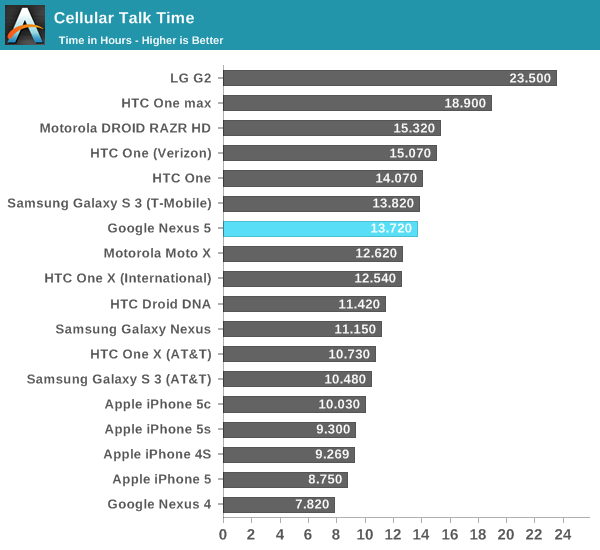
In the talk time test I was surprised to see a considerable falloff, although this is almost always gated by rock bottom power for the system. There clearly are some other consumers which either aren’t powering down all the way or LG has better optimized for on the G2 versus the Nexus 5 which is Google’s domain.
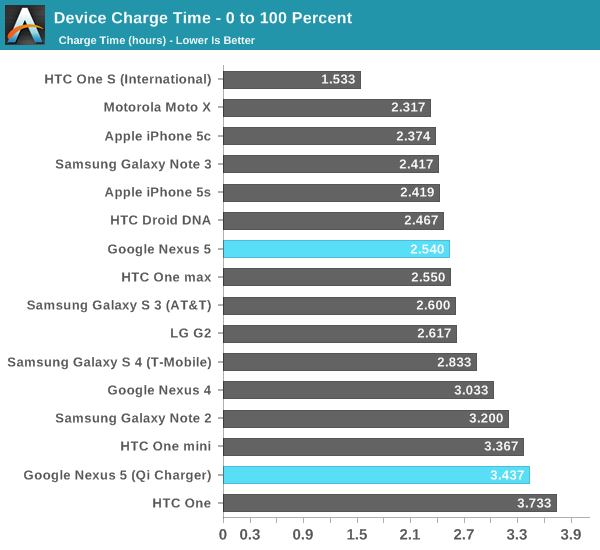
Looking at battery capacity alone would leave you with the impression that the Nexus 5 is woefully under-specced, when in reality battery life shows definite gains over previous generation devices. Although I’d love if the device somehow had the same size battery as the G2, it’s clearly enough to make it through at least a full day, and in my time daily driving the device I’ve yet to come up short.
When it comes to charging, Google continues to do the sane thing and implement BC 1.2 signaling. Unlike the LG Optimus G, the Nexus 5 does not use the battery charging IC Qualcomm makes for use in conjunction with its normal PMICs, instead it uses the TI BQ24192 to charge at up to 1.5 A maximum and a MAX17048 fuel gauge. This seems to be done in order to accommodate wireless charging, though there could be other cost considerations at play. The Nexus 5 seems to charge in the linear region at just above 1 A however, although the limit set for BQ24192 is 1.5 A, and has a total charge time just above 2.5 hours on the supplied 1.2 A charger.
As I mentioned, Nexus 5 also works with the Qi (prounounced “chee”) wireless charging specification which Google seems to have thankfully settled on for Nexus 4, 7, and now 5. The Nexus 5 uses TI’s bq51013b power supply and charge receiver which is WPC 1.1 compliant. I praised the Nexus 4 for how well implemented Qi charging was and how it charged in basically the same amount of time on the charging mat or USB, as far as I can tell the Nexus 5 continues to implement things properly and will charge at accelerated rates. I’ve seen a few handsets that include Qi but oddly enough only charge at 500 mA like a USB data port, this is thankfully not the case on Nexus 5.
Nexus Wireless Charger
Google sent along their first party Qi wireless charger as well and I had a chance to check it out. I’ve never used the charging “Orb” that shipped with Nexus 4 so I can’t comment on it, I have however used the two-position Energizer Qi charger and the Samsung Qi charger pad. Google’s universal Nexus wireless charger works with the other Qi compatible Nexus devices, Nexus 7 (2013), 4, and 5, and of course any Qi compliant devices. I tested with the Droid DNA and had no issues charging like any other Qi charger.
Google’s charger works in conjunction with a 9 Watt USB AC adapter and plugs into the charging puck over microUSB. What’s interesting about the charger is both how small it is (the outline is quite small) and how the bottom has a material that seems eerily reminiscent of what was on the bottom of the touchstone charger that shipped with the Palm Pre. The charger will securely adhere itself to surfaces, which it needs to since it has some magnets inside for alignment of devices.

I put some magnetic field viewing film on top of Google’s wireless charger, and you can see four magnets at the corners, which match up nicely with the four metal slugs on the back of the Nexus 5 around the charging coil.
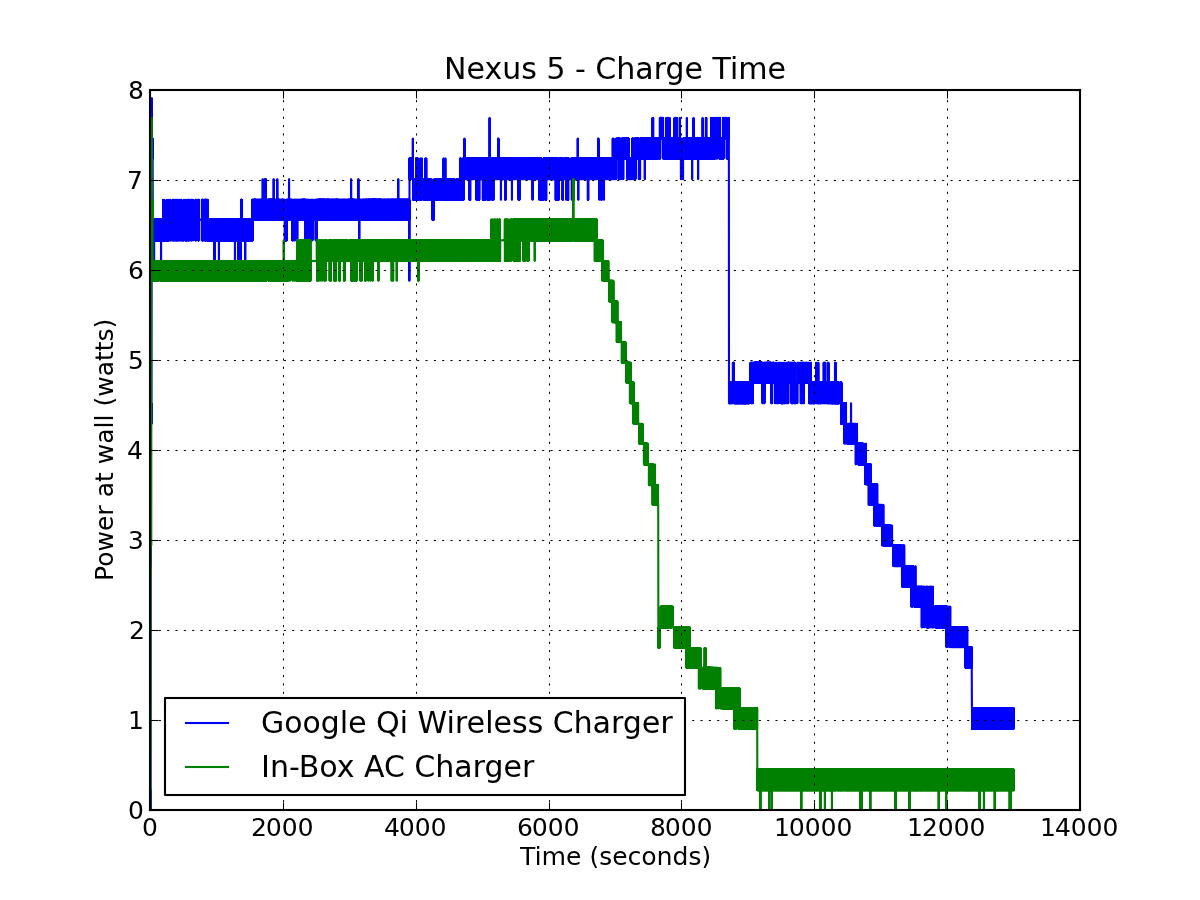
There’s still some overhead and loss with all wireless charging, including Qi. I measured and plotted the power draw and thus charge time for a fully drained Nexus 5 being charged both using the in-box supplied AC charger from Google, and their wireless charger. There ends up being about a 50 minute difference between the two, so you’re definitely trading convenience for a longer charge time, but once you’ve used wireless charging it’s hard to give up that convenience. At the very least, Google’s new charger addresses some of the complaints I saw levied against the original charging Orb with the inclusion of magnets that do seem to hold down devices better and keep them aligned so they charge properly, and included a very good grippy material on the back that adheres it to surfaces quite nicely.


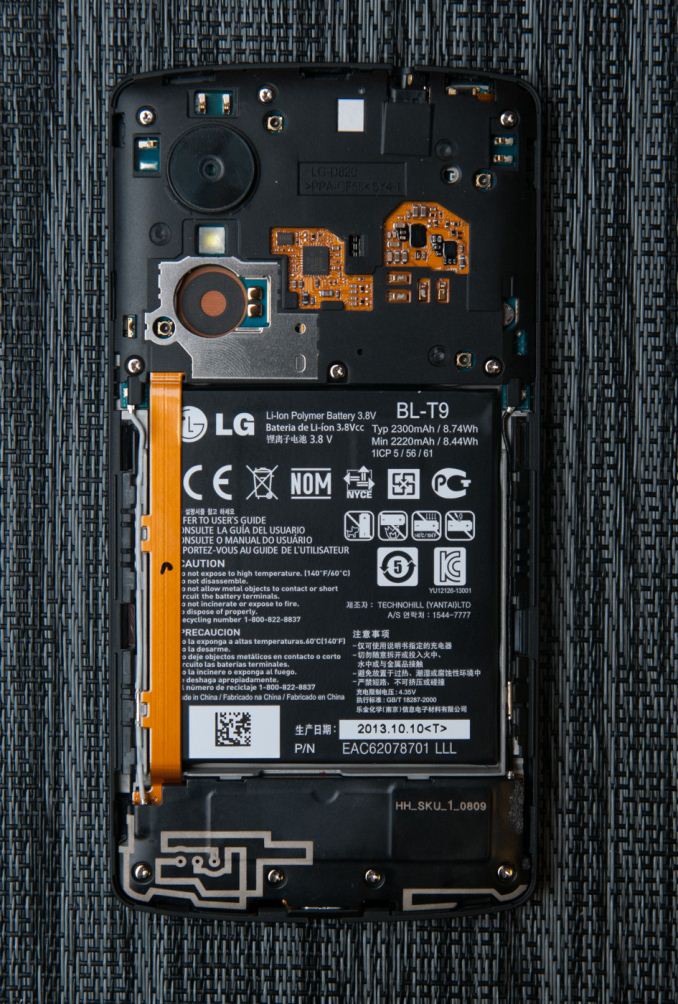
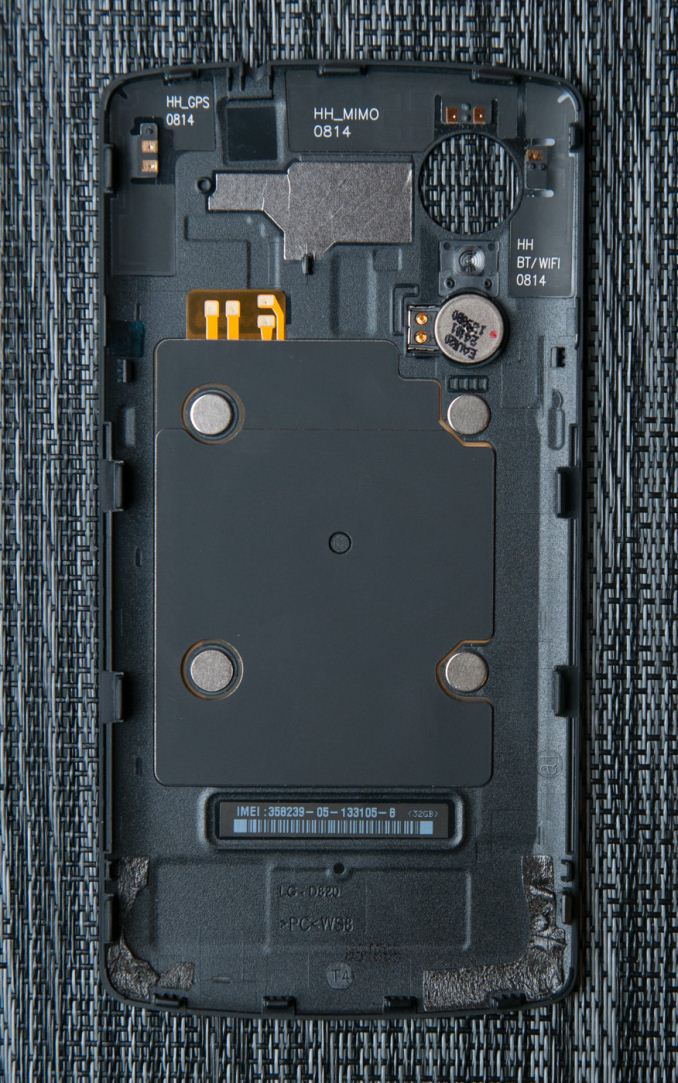
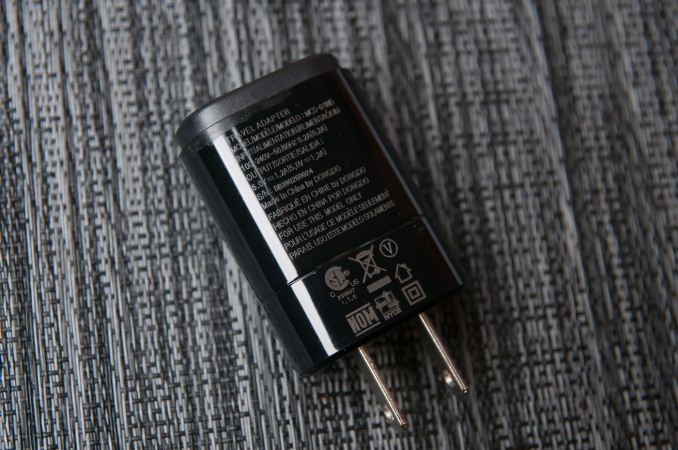
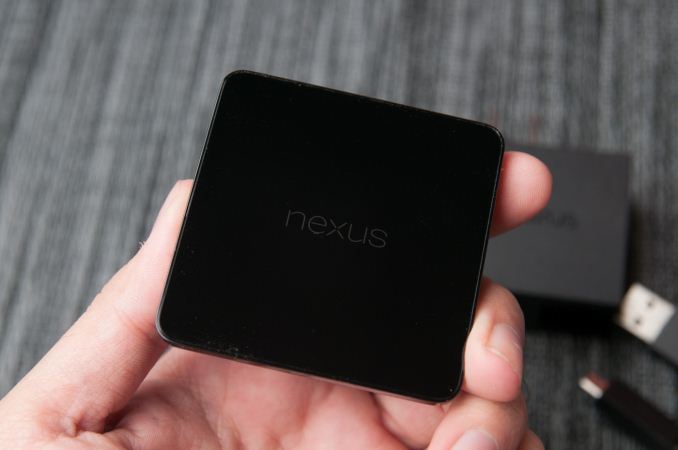














231 Comments
View All Comments
hrrmph - Thursday, December 5, 2013 - link
iPhones are upper-midrange. They don't have:- Tool-less removable back covers (Blackberry, Samsung);
- User replaceable batteries (Blackberry, Samsung);
- Internal user expandable local storage such as via Micro-SDXC slots (Blackberry, Samsung, Sony);
- Dual-SIM slots (Samsung S4, S4-Mini, and Note 3 have variants that are so equipped);
- MS Windows style easy-to-open, easy-to-reduce-to-thumbnail, easy-to-close multitasking windows (BB OS10);
- Interleaving of all communications in one list, such as SMS, Call Data, Email Accounts, Notifications, etc. (Again BB OS10);
- WMA-Lossless audio file support (Android and Blackberry); and
- 4K-60fps OIS-stabilized video recording (okay, nobody has it, but a real flagship device should).
flyingpants1 - Saturday, December 7, 2013 - link
Right. In addition to the screen size thing. And no NFC, or USB, no front speakers, no waterproof, no wireless charging.. there's actually a ton more..erple2 - Saturday, December 7, 2013 - link
To be fair, your first 3 points don't tell me high end at all. Those are just convenience features.The 4th one isn't really all that important outside of a few select markets, so scratch that.
The software itself isn't really a good reason to decide high, medium or low end - there are plenty of Apple Zealots that will tell you the many things Apple does that neither BBX nor Android do, and they'll place some sort of unrealistic weight to that small feature. Curiously, the more I use my phone, the less I care about the fancy interface of the multitasker. Android's method seems to work just fine for me.
The interleaving of communications sounds great, but it comes with one HUGE caveat - crappy app support for EVERYTHING ELSE.
WMA isn't really a deal breaker at all - iOS will play FLAC audio (with an additional app), or the native AppleLossless format.
Though having used an OIS phone in the past, I would consider that a high-end feature..
akdj - Monday, December 9, 2013 - link
What about performance? Camera quality? Eco system, app/development support and software available? Post purchase support? Immediate updates and 'point' updates to kill bugs? Oh, yeah... Performance? Did you happen to notice the 5/5s in the 'upper mid range' scoring in graphics, computational power, battery life (no need to replace batteries), a 64GB option (no need for an SD slot), who cares about dual SIM slot when damn near every "world radio" is built in? Buy a new SIM when you arrive at your destination, with minutes, for ten bucks! iPhones and iPads have long been able to playback lossless formats and FLAC. It's kinda cool, there's typically 'an app for that' when using iOS. Not so much using BB OS10. And Samsung's TouchWiz cream soup is thicker than mashed potatoes (I've got a Note 2). Their phones are more bloated than a new Compaq computer bought at Computer City in 2003 with Vista! I own Android and iOS devices. Daily drive a pair of phones. The Note2 and 5s. I can honestly tell you've got ZERO experience with iPhones...and need to before spewing such silly comments. Who needs 'tool less removable back covers' when your phone runs all day on a charge, doesn't break down, and has options for enough on board storage (that EVERYTHING can be loaded to vs. the VERY select few items I can put on my Note's SD card, essentially limited to media....which is available through iTunes Match via the cloud and doesn't need to be stored) to negate the need, again, to access anything inside!Couple other cool things. Post purchase support...Samsung? Fuggedaboutit! Apple? Take it to the store or call their number....usually they'll just hand you a new one...
...lastly, one thing I've found with my iPhones, I've always sold them and came out ahead after two year of usage! $300 out of pocket on the subsidy, use it two years, sell it for $375...pick up the latest model for $300 then enjoy a nice dinner...or pick up a Mophie case to double my 'juice' if necessary
BBOS 10---the integration of communications is a good idea....in theory. Then again, it's kinda nice to separate email from SMS, Facebook from voicemail....for me at least. As I run a business, some things need to be responded to a bit more professionally than others. I can see myself confusing what I'm responding to. With iOS 7's notification update, this is irrelevant anyway, as it's all just a swipe down front the top of ANY screen within ANY app. Again....use one and you'll educate yourself.
OIS is cool. But it takes up space to be done. And done right....HTC's ONE does get it right, albeit at the expense of shot detail (look at iPhone, Android of your choice vs HTC's pics, their all over as well as excellent reviews of each at dpreview, an excellent camera site, as well as DXOMark). Apple will incorporate it if the technology is there, allows it without sacrifice to shot quality or design aesthetics and usability. Their new burst mode is phenomenal....my 5s shoots faster (with s bigger buffer) than my Canon 7d! All the way up to 100 shots at damn near 10 shots a second....pics what it thinks are the best 'focus' shots so you don't have to dig through....and you can trash the rest.
Again....use one. You might be impressed....unless you enjoy taking your phones apart, then you're absolutely correct. The iPhone isn't for you
gus6464 - Thursday, December 5, 2013 - link
Will you guys be doing a Moto G review? It looks it would be an interesting review for the price it goes for and it's performance.Quicksand Jesus - Thursday, December 5, 2013 - link
Thank goodness there is still a site around that can do a REAL in depth review. I'm so tired of subjective reviews with opinions and no real substance. Other sites could learn alot from Anandtech!naalex - Thursday, December 5, 2013 - link
Thanks for long-awaited and much appreciated review Brian. I was hesitating on buying the Nexus 5 given the shoddy battery-life scaremongering on other websites, but I couldn't wait any longer, so I bought the phone before your review came out. So far, I was thinking I was deluding myself because the battery life has been superb, but your review confirms that the Nexus 5 isn't a dud after all.I also think the camera troubles are a bit overblown for "normal" users. Yes the camera app is wretched, and focusing is a mystery, but the phone can take good-quality pictures in good and low-light conditions. Photography geeks or more discriminating users might be able to tell the difference between the photos taken with the Nexus 5 and its competitors with better camera packages, but I think for most normal users, it's fine. And hella cheap!
grayson_carr - Thursday, December 5, 2013 - link
One thing I'm interested in that you didn't cover Brian. Viewing angles of the display. The viewing angles seem great when looking at the display directly from the sides, top, and bottom, but when looking at it from the corners, it looks seriously washed out (gamma shift?). Just wondering why it does that when HTC's high end LCDs always seem to look good from every angle. If the Nexus 5 is using the same display as the Droid DNA, I would guess it has to do with the Nexus 5 lacking some additional component? A polarization filter perhaps? Know what I'm talking about? Any ideas?Before people go saying "who looks at a device from the corners?", please consider the phone sitting on a table or desk. You usually don't sit it directly in front of you, but off to the side, meaning you're looking at it from a bottom corner if you want to quickly check a notification or something without picking it up. Or maybe you're just showing pictures to people around you. Chances are, they won't be looking at the phone directly from the side, but more from one of the corners. Your pictures might look great to you from directly in front of the phone, while looking washed out and crappy to others around you.
jamdev12 - Thursday, December 5, 2013 - link
Google is updating camera firmware today. Brian are you updating this post with an additional test for the camera? By the way thanks for finally getting this done. I know the holiday season is horrible to get things like this out, but it was well worth the wait.chandgupt - Thursday, December 5, 2013 - link
I believe the ppi is 445 instead of 480. This must affect your "dips" calculation for display size?